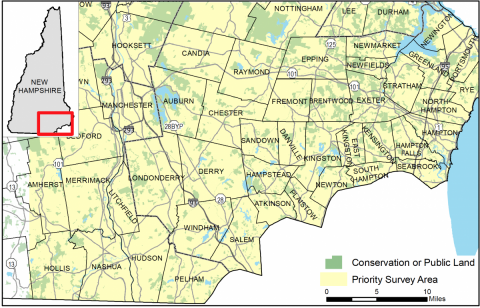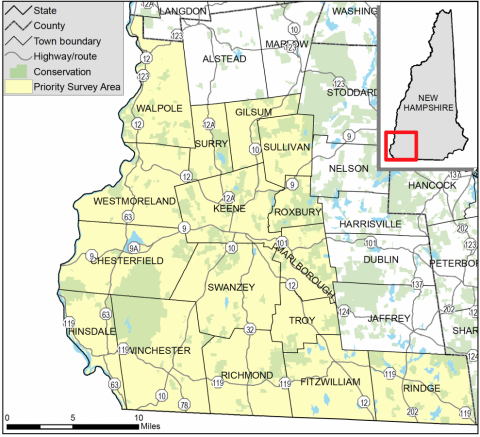There are two species of rabbits in New Hampshire - the eastern cottontail (Sylvilagus floridanus; EC) and the New England cottontail (Sylvilagus transitionalis; NEC). The eastern cottontail is not native east of the Hudson River and was introduced to New England in the early 1900s as a game species. The New England cottontail is native to New England but has seen dwindling population numbers over the last several decades throughout its range, mostly due to habitat loss and fragmentation, and is currently listed as a state-endangered species in New Hampshire.
New Hampshire is also home to one species of hare - the snowshoe hare (Lepus americanus), which are larger than our two rabbit species. Snowshoe hare turn white in the winter, and have large hind feet that allow them to travel easily in snow. Unlike cottontails, which are born in a nest and are blind at birth, the young of hare are born fully furred and ready to run.
New England cottontail, a state-endangered species, requires large areas of early-successional habitat to avoid predators and survive, and typically don’t venture far from these areas of thick shrubs and young trees. Eastern cottontails are able to venture farther from protective cover and are better able to survive in the human-dominated, fragmented habitats of New England. In many small habitat patches, eastern cottontails have replaced New England cottontails. Eastern cottontails probably do not directly oust New England cottontails from such areas, but may simply be able to survive in habitats that New England cottontails cannot use and may be better able to find and occupy new habitats as they become available, either due to natural disturbances or habitat management activities.
NH Fish and Game coordinates a comprehensive effort to survey for the presence of New England cottontail rabbits in and around the areas where they are known to be present. However, less is known about where and in what numbers eastern cottontails are found in New Hampshire. Sighting information from volunteers will help us understand the distribution and potential abundance of rabbit species in New Hampshire. Understanding the relationship between the distributions of New England cottontail and eastern cottontail is important in order to make informed decisions about where habitat management will be most effective for New England cottontail.
We are interested in information from all over New Hampshire, but there are certain areas where sightings will be extremely useful in helping us understand the relationship between the distributions of New England cottontail and eastern cottontail. Priority towns for sighting information are those towns in Southern New Hampshire where we currently have no data on the presence or distribution of eastern cottontail. This includes towns like Windham, Pelham, Salem, Atkinson, Plaistow, South Newton, Danville, Sandown, Kensington, Exeter, Stratham, and Fremont. We’re also interested in sighting information from towns that are in or around the New England cottontail focus areas, which includes towns like Amherst, Merrimack, Litchfield, Londonderry, Derry, Brentwood, and Newfields. As a general rule of thumb, anything south of Route 101 is a priority for collecting sighting information. There are also towns in the Southwestern part of New Hampshire that are priorities for rabbit sighting information - see the maps below.

Priority survey areas for rabbit sighting information in Southeast New Hampshire.

Priority survey areas for rabbit sighting information in Southwest New Hampshire.
When submitting a sighting to NH Rabbit Reports, we will ask you to include the date and time of the observation, as well as the location of the sighting (address, intersection, or GPS coordinates). We will also ask you describe the area and habitat where you saw the rabbit – e.g. backyard, shrubs, forest, roadside, size of the area, etc.
You will also have the opportunity to upload a picture, which may help us determine the species of rabbit you saw. Visit Tips for Photographing Rabbits for information on how to take a photo that provides the most information possible for trying to determine the species.
If you think the rabbit in your yard could be a New England cottontail please submit a rabbit report. There is no need to do anything for the rabbit, but leave it alone. If you have a rabbit in your yard that is causing damage, you may call a certified Wildlife Control Operator to assist you with trapping and relocating the rabbit. You may also legally trap and relocate the rabbit yourself. It is important that you do not relocate the rabbit into a recovery area for New England cottontails. Refer to the NH Hunting Digest for towns that are closed to cottontail hunting; these are the towns where you should not release a rabbit of any kind. Written landowner permission is required for any property that the rabbit is released to. If you are concerned about the identification of the species of rabbit that is in your yard, please contact NH Fish and Game for assistance.

